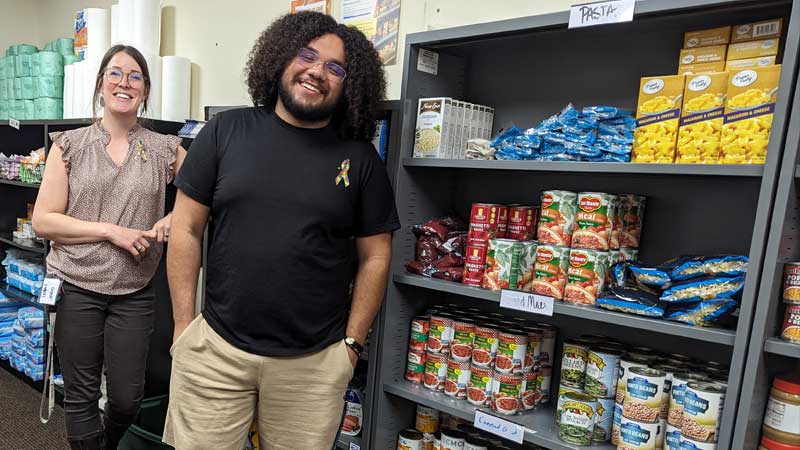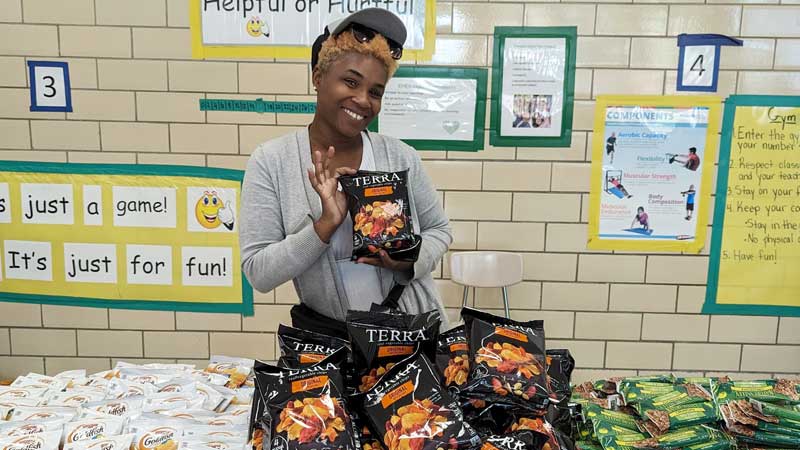Teaching Hunger a Lesson: School Pantry 101

1 in 3 Maryland Children face hunger on any given day, and that is an irrational number.
The next time you are at your grandchild’s basketball game, take a closer look: two or three of those budding athletes may be battling an unseen defender—hunger.
The fact that Maryland continues to be one of the wealthiest states in the country makes it all the more unacceptable that some kids continue to encounter challenges their teammates will not.
So, how do we level the playing field? Partnerships, Pantries, and Proactivity.
Not long after Anne Miller founded MFB (the first food bank on the east coast) in 1979, another Maryland institution, Giant Food, saw an opportunity to provide some new resources for residents of the Old Line state, beginning a partnership that has grown, flourished, and continues to help Maryland’s children and families statewide today.

“Through our partnership with the Maryland Food Bank, we’ve been able to engage with families and our communities at a really important developmental stage, not only to provide nutritious food and nutrition education to young people, but to also provide regular volunteer opportunities for our associates that want to engage in the mission,” said Dyani Hanrahan, Vice President of Marketing and Community Relations, Giant Food; Board Member, Maryland Food Bank.
With the support of Giant Food we’re able to extend that partnership into local communities, meeting families where so much of their time is invested already—school.
In FY23, your support of partnerships between MFB and local schools made it possible for neighbors to access almost 2.5 million meals from nearly 190 School Pantries. And with a high average meal cost in Maryland—as much as $4.86 in Baltimore City—you can easily see how School Pantries can positively affect families’ budgets.
In previous newsletters, you’ve read about our efforts to hone this program into something even more impactful, and we’re continuing that work. Maryland’s statewide Community Schools Program provides an excellent partnership opportunity to increase access to nutritious foods, while opening pathways out of hunger for more families. And we’re already seeing the needle move in central Maryland.

Community Schools Offer Neighbors Valuable Tools
In 2022, when Rachel Valsing came to West Baltimore’s Johnnycake Elementary School, the first thing she did was a needs assessment to find out how to best serve as its first-ever Community School Facilitator.
“What came up as a real need in our community was increased access to healthy foods. We had been providing some supplemental weekend meals though a smaller partnership, but in listening sessions, it became clear that food was a much bigger issue than we thought, so I reached out to the Maryland Food Bank,” said Rachel.
Using language similar to MFB 3.0, our strategic plan, the State of Maryland describes the Community Schools initiative as “leveraging the power of the collective allows community schools to provide resources to students and families where they need them the most—neighborhoods that have been historically underfunded and underserved. Community schools provide a wide array of wraparound services that enhance students’ ability to be successful.”
Extending their reach even further, food distribution events rotate among nearby schools in other underfunded and underserved communities, including Edmondson Heights, where Lisa P. recently visited the pantry.

The Rite Aid Helps Chart a United Way
Echoing MFB’s own strategic plan, the Rite Aid Healthy Futures program is “dedicated to supporting communities through equitable access to the things they need most. Teaming with local organizations, we seek systemic change that will uplift all of us, together. Because when our neighbors thrive, so do we.”
At another Community School located just five miles east of Edmonson Heights, The Excel Academy is collaborating with multiple partners to help vulnerable families living in the historically underresourced Poppleton neighborhood, where the only grocery store that was within walking distance recently closed.
“Just like families are able to do more with their budgets due to the food and resources students access at school, support from The United Way, Rite Aid Healthy Futures, and the Maryland Food Bank allows us to extend our reach, and bring in more food, or help alleviate other issues,” said Tony Jarrett, Community School Coordinator, The Excel Academy.
MFB’s Regional Program Directors are constantly innovating, seeking ways to improve the efficiency and impact of our partner network, which can help more Marylanders thrive. And the shared goals of removing barriers to success and providing wraparound services that address root causes makes partnering with Community Schools a natural, strategic fit. This intentional work is allowing more students to graduate from food insecurity, with fewer having to drag that unwanted baggage to college. But until that rate is 100%, we’ll continue expanding partnerships with Maryland’s higher education institutions.
“Why am I here? Well, I was recently laid off from my job at Dollar Tree, and I can’t get unemployment because I wasn’t working there long enough. So, this offering at my grandchildren’s school is perfect. I was able to get this catfish, soup, and applesauce that they just love!”
Chesapeake College’s Corner of Care is Liberating Students
If a family can send a child to college, they must be well off enough to afford the basic necessities, right?
Wrong.
In reality, college students tend to experience food insecurity at much higher rates than the general public. In Maryland, 1 in 3 adults is food insecure, but college students are 3 to 4 times more likely to not know where their next meal is coming from, and 79.2% students at four Historically Black Colleges and Universities reported some level of food insecurity.
Serving attendees from five rural counties, Wye Mills’ Chesapeake College is addressing their students’ needs through the Corner of Care—a holistic approach that begins with food but seeks to address some of the root causes that derail their education journeys.
“Students can just come here, and they will find a community that cares—and honestly there’s no judgment—anybody’s welcome here at the Corner of Care. ” said Brando Banda-Perez, Class of 2026.
Started in the mid 2010’s, the Corner of Care has evolved from a literal corner in a closet, to a larger, discreet space that Director of Student Engagement and Development Cheyenne Roache says students now call “The Kitchen, because it’s not only a place to get food, but you’ll notice people just hanging out talking about classes and sharing resources—we try to make it a place that is welcoming to anyone who needs it.”

Information and connections to resources abound in the Corner of Care, showing students how to apply for gas cards or bus tickets to alleviate some of the transportation challenges, as well as clothing, toiletries, hygiene products, and food safety tips.
“We have several hundred people coming through here each month—nurses that have to get the clinicals, parents that are running back and forth to work and school, and just your everyday students—we try to have something for everyone,” said Cheyenne.
But ensuring that all students—from Kindergarten to college—have access to healthy food at school is not enough. Because just like hunger doesn’t magically end after one’s senior year, it also doesn’t vanish on weekends or over the summer.

Shouldering the Load
Since 2015, the Weekend Backpacks program has been helping Baltimore City students and families bridge that often-difficult time between Friday afternoon dismissal and the Monday morning tardy bell, when kids lose access to school meals. For years, the organization supported about 600 students, but due to an expanded partnership with the Maryland Food Bank, and funding from food bank friends at the Baltimore Ravens Foundation, Mariner Finance, and others, Weekend Backpacks is a lean, mean, hunger-fighting machine offering access to more 1,800 students at 50 schools.
“Being able to bring the 40 years of experience and expertise of the Maryland Food Bank to help Weekend Backpacks streamline and now support triple the number of neighbors is precisely what the food bank is about in 2024,” said Rebecca Mann, MFB’s Regional Program Director.
“A lot of times, I get stuck in traffic, and don’t have time for a real breakfast, so being able to come to the Corner of Care and grab a protein bar makes a real difference in my day.”
And while the program’s output has increased, the increased nutritional quality of the food and accompanying nutrition education (like recipes and menu tips) should lead to better outcomes.
“Working more closely with the food bank has allowed us to offer healthier foods,” said Christy Keppel, Executive Director, Weekend Backpacks. “Now, 70% of the contents are green and yellow SWAP items—simple things like brown rice instead of white rice—and families really appreciate that.”
Taking a 24 hours-a-day, 7 days-a-week approach is a central part of our efforts to feed children. We’re fortunate to partner with organizations like Weekend Backpacks that address this vulnerable “out of school” time. But what about evenings and summers? How do we care for kids then? By hosting Summer Clubs and Supper Clubs! ![]()

About The Author
Ben Gross
For more than 30 years, Ben has been helping organizations raise awareness and inspire action by creating compelling narratives. And since 2018, Ben has been the Maryland Food Bank's Staff Writer, elevating the voices of food-insecure neighbors to further the Maryland Food Bank's mission of feeding people, strengthening communities, and ending hunger for more Marylanders.
We Need Your Help
Programs, campaigns, and educational outreach at the Maryland Food Bank has always relied on the philanthropic support of charitable individuals like you.
Much like our food distribution efforts, outreach activities at the Maryland Food Bank rely on generous donations of money and time.
We hope you’ll consider a contribution.







